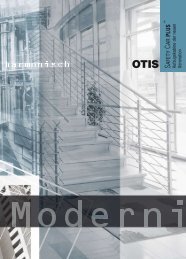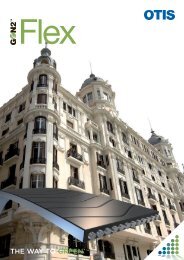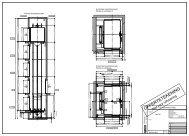Otis 100 anos no Brasil 1 - Otis Elevator Company
Otis 100 anos no Brasil 1 - Otis Elevator Company
Otis 100 anos no Brasil 1 - Otis Elevator Company
You also want an ePaper? Increase the reach of your titles
YUMPU automatically turns print PDFs into web optimized ePapers that Google loves.
<strong>Otis</strong> <strong>100</strong> <strong>a<strong>no</strong>s</strong> <strong>no</strong> <strong>Brasil</strong> 1
2 <strong>Otis</strong> <strong>100</strong> <strong>a<strong>no</strong>s</strong> <strong>no</strong> <strong>Brasil</strong>
<strong>100</strong> years in Brazil<br />
<strong>Otis</strong> <strong>100</strong> <strong>a<strong>no</strong>s</strong> <strong>no</strong> <strong>Brasil</strong> 3
4 <strong>Otis</strong> <strong>100</strong> <strong>a<strong>no</strong>s</strong> <strong>no</strong> <strong>Brasil</strong>
<strong>Otis</strong> <strong>100</strong> <strong>a<strong>no</strong>s</strong> <strong>no</strong> <strong>Brasil</strong> 5
6 <strong>Otis</strong> <strong>100</strong> <strong>a<strong>no</strong>s</strong> <strong>no</strong> <strong>Brasil</strong>
No topo do mundo<br />
On top of the world<br />
<strong>Otis</strong> <strong>100</strong> <strong>a<strong>no</strong>s</strong> <strong>no</strong> <strong>Brasil</strong> 7
8 <strong>Otis</strong> <strong>100</strong> <strong>a<strong>no</strong>s</strong> <strong>no</strong> <strong>Brasil</strong><br />
No topo do mundo<br />
P<br />
oucas companhias <strong>no</strong> <strong>Brasil</strong> chegam aos cem <strong>a<strong>no</strong>s</strong><br />
de atividade esbanjando tanto vigor, dinamismo,<br />
criatividade e senso de i<strong>no</strong>vação tec<strong>no</strong>lógica. E exibindo uma<br />
presença de mercado impressionante, a ponto de fazer parte<br />
da vida de milhões de pessoas que transitam diariamente<br />
pelos principais edifícios do país ou por residências verticais<br />
de todos os padrões.<br />
A Elevadores <strong>Otis</strong> é uma delas. A empresa é subsidiária da<br />
<strong>no</strong>rte-americana <strong>Otis</strong> <strong>Elevator</strong> <strong>Company</strong>, que atravessou o<br />
século <strong>no</strong> topo da liderança mundial dos segmentos de<br />
produtos e serviços para elevadores, escadas e esteiras<br />
rolantes. Ela se insere hoje como uma das mais bem-sucedidas<br />
operações da <strong>Otis</strong> mundial, cuja criação se deu em meados<br />
do século 19, <strong>no</strong>s Estados Unidos.<br />
Hoje, presente com igual tec<strong>no</strong>logia em mais de 200<br />
países, o grupo <strong>Otis</strong> integra o conglomerado<br />
internacional United Tech<strong>no</strong>logies Corporation (UTC).<br />
Uma das maiores corporações industriais do mundo, com<br />
mais de 215 mil funcionários e vendas globais anuais<br />
superiores a US$ 47,8 bilhões.<br />
A UTC é formada por grandes companhias líderes em seus<br />
respectivos segmentos. Entre seus produtos mais<br />
conhecidos estão os aparelhos de ar-condicionado<br />
Carrier, os helicópteros Sikorsky e as turbinas Pratt &<br />
Whitney.<br />
On top of the world<br />
Few companies in Brazil have marked <strong>100</strong> years of activity with<br />
such strength, dynamism, creativity and sense of technical<br />
in<strong>no</strong>vation. At the same time, few companies have such an<br />
imposing market presence that they are part of the lives of<br />
millions of people who use their products, whether in high-tech<br />
office buildings or high-rise vertical residences of all kinds.<br />
Elevadores <strong>Otis</strong> is one of these few companies. It is a subsidiary<br />
of <strong>Otis</strong> <strong>Elevator</strong> <strong>Company</strong>, founded in the middle of the 19th<br />
century in the United States. <strong>Otis</strong> has been the world leader in<br />
products and services for elevator and escalator products and<br />
services for over a century. The Brazilian operation is one of<br />
<strong>Otis</strong>’s most successful in the world.<br />
The <strong>Otis</strong> group is <strong>no</strong>w present in more than 200 countries. It<br />
belongs to the international conglomerate, United Tech<strong>no</strong>logies<br />
Corporation (UTC), one of the largest industrial corporations<br />
in the world, with over 215,000 employees and annual global<br />
sales of more than US$ 47,8 billion.<br />
UTC consists of large companies that are leaders in their<br />
respective fields. Among the best-k<strong>no</strong>wn products are Carrier
A <strong>Otis</strong> registra números invejáveis <strong>no</strong> seu portfólio<br />
empresarial, como ser a responsável pela manutenção<br />
de cerca de 1,9 milhão de elevadores e mais de 130<br />
mil escadas rolantes em operação <strong>no</strong> mundo,<br />
transportando milhões de pessoas por dia, com o apoio<br />
e talento de aproximadamente 61 mil funcionários.<br />
A <strong>Otis</strong> é referência absoluta em modernidade e<br />
qualidade em todo o planeta. Mas é também sinônimo<br />
de i<strong>no</strong>vação e talento inventivo. Tanto, que se é verdade,<br />
que só quem sonha vence o próprio tempo, a empresa<br />
é a própria confirmação dessa máxima.<br />
O fundador da companhia ousou projetar um mundo<br />
diferente do que existia quando a criou. Sonhou com<br />
edifícios altos, elegantes e capazes até de arranhar o céu.<br />
Justamente quando as construções ainda tinham<br />
limitações extremas de crescimento e eram acanhadas<br />
e baixas. E conseguiu. Ele fez com que a imaginação<br />
de arquitetos e construtores de todo o mundo deixasse<br />
de parar <strong>no</strong> terceiro andar, dando liberdade ao homem<br />
para se lançar cada vez mais alto em suas construções,<br />
que invadiram as paisagens das grandes metrópoles<br />
do mundo.<br />
Da terra, se alcança hoje as alturas em poucos minutos<br />
a bordo dos cada vez mais i<strong>no</strong>vadores e seguros<br />
sistemas de transporte vertical, graças à genialidade<br />
<strong>Otis</strong> <strong>100</strong> <strong>a<strong>no</strong>s</strong> <strong>no</strong> <strong>Brasil</strong> 9<br />
air conditioning appliances, Sikorsky helicopters and Pratt &<br />
Whitney turbines.<br />
<strong>Otis</strong>’s business portfolio is packed with enviable figures. It is<br />
responsible for maintaining around 1.9 million elevators and more<br />
than 130,000 escalators throughout the world, and transporting<br />
millions of people every day. This achievement is made possible<br />
through the efforts and talent of approximately 61,000 employees.<br />
<strong>Otis</strong> is an absolute benchmark in terms of modernity and quality<br />
throughout the world. At the same time, it is also sy<strong>no</strong>nymous<br />
with in<strong>no</strong>vation and inventive talent. The company is an example<br />
that dreamers can overcome the limitations of their own time.<br />
The man who founded <strong>Otis</strong> dared to imagine a different world<br />
from that which existed in his time. He dreamed of elegant,<br />
high-rise buildings that could touch the sky.<br />
He had this vision at a time when buildings were still limited in<br />
terms of height and remained low. He succeeded in achieving<br />
his dream and, in doing so, freed architects and builders all<br />
around the world from the limitations of a maximum height of<br />
three to five floors. This breakthrough allowed Man to launch<br />
himself into the sky and build higher buildings that changed
10 <strong>Otis</strong> <strong>100</strong> <strong>a<strong>no</strong>s</strong> <strong>no</strong> <strong>Brasil</strong><br />
de outro empreendedor visionário que o universo legou à<br />
humanidade: Elisha Graves <strong>Otis</strong>, que criou em 1852, na<br />
cidade de Yonkers, nas proximidades de Nova York, <strong>no</strong>s<br />
EUA, o primeiro elevador de segurança do mundo.<br />
Depois dele, a paisagem urbana do mundo nunca mais<br />
foi a mesma.<br />
A sua invenção transporta o homem hoje a centenas de metros<br />
para cima e para baixo, nas mais diversas situações.<br />
Ou, simplesmente, transportando as pessoas para locais<br />
de trabalho me<strong>no</strong>s insólitos, para suas residências, após<br />
o expediente, ou em qualquer outro tipo de edifício.<br />
the landscapes of the world’s largest, cities.<br />
People can soar from the ground in a few minutes with<br />
increasingly in<strong>no</strong>vative and safer vertical transport systems,<br />
thanks to the genius of Elisha Graves <strong>Otis</strong>, who created the first<br />
safe elevator in Yonkers, New York, in 1852.<br />
After him, the world’s urban landscape was never the same.<br />
His invention today transports Man above and below ground<br />
level in the most diverse situations.<br />
Or, simply transports people to more commonplace destinations,<br />
such as their workplace, homes and other buildings.
Elisha Graves <strong>Otis</strong>:<br />
inventor do primeiro elevador<br />
de segurança<br />
Elisha Graves <strong>Otis</strong>:<br />
inventor of the the first safe elevator<br />
Depois dele, o mundo nunca mais foi o mesmo.<br />
�<br />
After him, the world´s urban landscape was never the same.<br />
<strong>Otis</strong> <strong>100</strong> <strong>a<strong>no</strong>s</strong> <strong>no</strong> <strong>Brasil</strong> 11
12 <strong>Otis</strong> <strong>100</strong> <strong>a<strong>no</strong>s</strong> <strong>no</strong> <strong>Brasil</strong>
Primeira fábrica da <strong>Otis</strong> <strong>no</strong> mundo<br />
- Yonkers, Nova York, em 1853<br />
First <strong>Otis</strong> plant in the world<br />
- Yonkers, New York, 1853<br />
Protótipo do elevador<br />
de segurança<br />
Prototype of<br />
safety elevator<br />
<strong>Otis</strong> <strong>100</strong> <strong>a<strong>no</strong>s</strong> <strong>no</strong> <strong>Brasil</strong> 13
14 <strong>Otis</strong> <strong>100</strong> <strong>a<strong>no</strong>s</strong> <strong>no</strong> <strong>Brasil</strong>
A esquerda, Palácio de Cristal, NY, 1854 local onde o sr. <strong>Otis</strong> apresentou o elevador<br />
de segurança.<br />
A direita sr. <strong>Otis</strong> apresentando o elevador de segurança na feira internacional, do<br />
Palácio de Cristal.<br />
Left, the Crystal Palace, NY, 1854, where Mr. <strong>Otis</strong> unveiled the safety elevator.<br />
Right, Mr. <strong>Otis</strong> presenting the safety elevator at the international trade fair at the Crystal Palace.<br />
<strong>Otis</strong> <strong>Otis</strong> <strong>100</strong> <strong>a<strong>no</strong>s</strong> <strong>a<strong>no</strong>s</strong> <strong>no</strong> <strong>no</strong> <strong>Brasil</strong> 15<br />
15
16 <strong>Otis</strong> <strong>100</strong> <strong>a<strong>no</strong>s</strong> <strong>no</strong> <strong>Brasil</strong><br />
1857 – E. V Haughwout & Co. –<br />
Nova York – EUA. Edifício em que foi instalado<br />
o primeiro elevador de passageiros <strong>no</strong> mundo<br />
1857 - E. V Haughwout & Co. -<br />
New York. Building where the first passenger<br />
elevator in the world was installed
Ao lado, antigo sistema de elevação<br />
Side, old elevation system<br />
<strong>Otis</strong> <strong>100</strong> <strong>a<strong>no</strong>s</strong> <strong>no</strong> <strong>Brasil</strong> 17
18 <strong>Otis</strong> <strong>100</strong> <strong>a<strong>no</strong>s</strong> <strong>no</strong> <strong>Brasil</strong>
<strong>Otis</strong> <strong>100</strong> <strong>a<strong>no</strong>s</strong> <strong>no</strong> <strong>Brasil</strong> 19<br />
Elevador com motor a<br />
vapor - patenteado pela<br />
<strong>Otis</strong> em 1861<br />
<strong>Elevator</strong> powered by steam<br />
- patented by <strong>Otis</strong> in 1861
20 <strong>Otis</strong> <strong>100</strong> <strong>a<strong>no</strong>s</strong> <strong>no</strong> <strong>Brasil</strong><br />
Elevador elétrico<br />
Electric elevator
Mecanismo de elevação<br />
Elevation mechanism<br />
<strong>Otis</strong> <strong>100</strong> <strong>a<strong>no</strong>s</strong> <strong>no</strong> <strong>Brasil</strong> 21
22 2 2 <strong>Otis</strong> <strong>100</strong> <strong>a<strong>no</strong>s</strong> <strong>no</strong> <strong>Brasil</strong><br />
1900 – Escada rolante<br />
1900 - Escalator
Propagandas<br />
Advertising<br />
<strong>Otis</strong> <strong>100</strong> <strong>a<strong>no</strong>s</strong> <strong>no</strong> <strong>Brasil</strong> 23
24 <strong>Otis</strong> <strong>100</strong> <strong>a<strong>no</strong>s</strong> <strong>no</strong> <strong>Brasil</strong><br />
Cem <strong>a<strong>no</strong>s</strong> de i<strong>no</strong>vação<br />
<strong>100</strong> years of in<strong>no</strong>vation
<strong>Otis</strong> <strong>100</strong> <strong>a<strong>no</strong>s</strong> <strong>no</strong> <strong>Brasil</strong> 25
26 <strong>Otis</strong> <strong>100</strong> <strong>a<strong>no</strong>s</strong> <strong>no</strong> <strong>Brasil</strong><br />
Cem <strong>a<strong>no</strong>s</strong> de i<strong>no</strong>vação<br />
M<br />
aior companhia mundial do segmento de<br />
elevadores, a <strong>Otis</strong> acompanha a evolução do<br />
transporte vertical <strong>no</strong> <strong>Brasil</strong> com equipamentos elétricos<br />
desde o início do século XX, investindo consistentemente<br />
em tec<strong>no</strong>logia, qualidade e criatividade.<br />
A esses vigorosos ingredientes de sucesso, a <strong>Otis</strong> alia<br />
ainda o estímulo permanente à experiência criativa e ao<br />
talento de seus milhares de funcionários. Estes<br />
diferenciais fazem-na movimentar-se agilmente e<br />
colocando-a sempre, e cada vez mais, à frente de seu<br />
próprio tempo.<br />
A companhia que mudou o mundo há mais de 150 <strong>a<strong>no</strong>s</strong>,<br />
continua introduzindo meios rápidos, seguros e<br />
confiáveis de movimentação de pessoas. Tanto que um<br />
de seus mais recentes lançamentos, que incorpora as<br />
mais avançadas i<strong>no</strong>vações do setor, comprova que a sua<br />
receita de êxito está realmente centrada na i<strong>no</strong>vação<br />
tec<strong>no</strong>lógica, qualidade e criatividade.<br />
Trata-se do <strong>no</strong>tável sistema Gen2, uma verdadeira i<strong>no</strong>vação<br />
<strong>no</strong> transporte vertical e que serve para consagrar a<br />
companhia, uma vez mais, como referência mundial do setor.<br />
O Gen2 tem um vigoroso sistema de cintas de aço<br />
revestidas de poliureta<strong>no</strong>, mais flexíveis, duráveis e mais<br />
fortes que os cabos comumente usados para suspender<br />
a cabina do elevador.<br />
<strong>100</strong> years of in<strong>no</strong>vation<br />
<strong>Otis</strong> is the world's leading elevator company and has<br />
accompanied the development of vertical transportation<br />
in Brazil since the beginning of the 20th century. It still<br />
maintains its leadership of the sector by constantly<br />
investing in tech<strong>no</strong>logy, quality and creativity.<br />
<strong>Otis</strong>'s success is enhanced by its constant encouragement<br />
to the company's thousands of employees to be creative<br />
and use their talents. This forward-looking approach has<br />
brought flexibility and has allowed <strong>Otis</strong> to always be at<br />
the forefront of change.<br />
The company, which changed the world more than 150 years<br />
ago, continues to introduce fast, safe and reliable means<br />
of moving people. One of its most recent launches<br />
incorporates the most in<strong>no</strong>vative advances in the sector<br />
and shows that its end results stem from tech<strong>no</strong>logical<br />
re<strong>no</strong>vation, quality and creativity.<br />
The remarkable Gen2 system is a genuine breakthrough<br />
in vertical transportation that has made the company a<br />
world leader in the sector once more.
Como resultado prático dessas i<strong>no</strong>vações, o <strong>no</strong>vo<br />
elevador ocupa apenas um quarto do tamanho dos<br />
equipamentos tradicionais e dispensa a construção de<br />
casa de máquinas.<br />
Com isso, o sistema de transporte vertical assume um<br />
<strong>no</strong>vo nível de excelência e se consolida nas realizações<br />
i<strong>no</strong>vadoras da empresa e de sua reconhecida tec<strong>no</strong>logia<br />
de qualidade.<br />
Além disso, consciente de sua função social, a empresa<br />
procura alinhar as tec<strong>no</strong>logias e as matérias-primas de<br />
ponta a alguns dos mais importantes preceitos do século<br />
21: eficiência energética, proteção ambiental e<br />
segurança dos usuários.<br />
<strong>Otis</strong> <strong>100</strong> <strong>a<strong>no</strong>s</strong> <strong>no</strong> <strong>Brasil</strong> 27<br />
Gen2 has a revolutionary system of steel belts coated with<br />
polyurethane, which is more flexible, durable and stronger<br />
than the cables commonly used to suspend the elevator cabin.<br />
As a result of these in<strong>no</strong>vations the new Gen2 elevator<br />
occupies only a quarter of the space of traditional<br />
equipment and removes the need to build a separate<br />
machine room.<br />
The Gen2 vertical transport system is taking on a new level<br />
of excellence and establishing its position in the market<br />
through the company's in<strong>no</strong>vation and the recognized<br />
quality of its tech<strong>no</strong>logy.<br />
At the same time, the company is aware of its social<br />
responsibilities and aims to align its tech<strong>no</strong>logies and use<br />
of raw materials to some of the most important concepts<br />
of the 21st century: energy efficiency, environmental<br />
protection and user safety.
28 <strong>Otis</strong> <strong>100</strong> <strong>a<strong>no</strong>s</strong> <strong>no</strong> <strong>Brasil</strong>
<strong>Otis</strong> <strong>100</strong> <strong>a<strong>no</strong>s</strong> <strong>no</strong> <strong>Brasil</strong> 29<br />
O mundo anda de OTIS<br />
The world is moved by <strong>Otis</strong>
30 <strong>Otis</strong> <strong>100</strong> <strong>a<strong>no</strong>s</strong> <strong>no</strong> <strong>Brasil</strong>
<strong>Otis</strong> <strong>100</strong> <strong>a<strong>no</strong>s</strong> <strong>no</strong> <strong>Brasil</strong> 31
32 <strong>Otis</strong> <strong>100</strong> <strong>a<strong>no</strong>s</strong> <strong>no</strong> <strong>Brasil</strong><br />
O mundo anda de OTIS<br />
H oje, ao mais suave dos toques, os elevadores<br />
transportam de forma célere, silenciosa e segura<br />
bilhões de pessoas ao topo dos mais altos edifícios do<br />
mundo. E proporcionam com toda segurança o<br />
deslumbramento das mais espetaculares vistas das<br />
paisagens urbanas do planeta.<br />
Do Cristo Redentor, <strong>no</strong> Rio de Janeiro, à Torre Eiffel,<br />
em Paris, ou ao Citicorp Center, em Nova York, passando<br />
pelo hotel mais alto do mundo, o Westin Stamford, em<br />
Cingapura – com seus 73 andares e 79 elevadores – ou,<br />
ainda, pelos edifícios Word Trade Center, de São Paulo<br />
e de Bue<strong>no</strong>s Aires ou pelo Centro Mundial do Comércio<br />
na Cidade do México, o sistema de transporte é o<br />
mesmo: <strong>Otis</strong>, é a marca escolhida atualmente por 8 dos<br />
20 edifícios mais altos do planeta.<br />
As Petronas Twin Towers, em Kuala Lampur, na Malásia;<br />
o Hong Kong e Shanghai Bank, na China; o Luxor Hotel,<br />
em Las Vegas, <strong>no</strong>s Estados Unidos; ou os elevadores<br />
pa<strong>no</strong>râmicos que deslizam por tubos de vidro na CN<br />
Tower, em Toronto, Canadá, na mais alta estrutura<br />
isolada existente <strong>no</strong> mundo, são algumas das<br />
construções mais famosas que optaram pela marca.<br />
Da mesma forma, o centenário complexo Raffles City,<br />
em Cingapura, e os legendários Chrysler e Empire State<br />
Building, em Nova York, Estados Unidos, bem como o<br />
The world is moved by <strong>Otis</strong><br />
Today, with just the lightest of touches, elevators transport billions<br />
of people to the top of the highest buildings in the world swiftly,<br />
silently and safely, and present them with the most spectacular<br />
urban landscapes in the world.<br />
<strong>Otis</strong> is responsible for the vertical transportation systems in the<br />
following monuments and buildings - the Christ the Redeemer<br />
statue in Rio de Janeiro; the Eiffel Tower in Paris; the Citicorp Center<br />
in New York; the Westin Stamford in Singapore, the tallest hotel in<br />
the world with 73 floors and 79 elevators; and the World Trade<br />
Center buildings in São Paulo, Bue<strong>no</strong>s Aires and the Centro Mundial<br />
do Comercio in Mexico City. Eight of the 20 tallest buildings in the<br />
world currently use the <strong>Otis</strong> brand.<br />
Some of the most famous buildings which have chosen the <strong>Otis</strong><br />
brand include the Petronas Twin Towers in Kuala Lumpur, Malaysia;<br />
the Hong Kong and Shanghai Bank, China; the Luxor Hotel, Las<br />
Vegas; and the CN Tower in Toronto, Canada, where pa<strong>no</strong>ramic<br />
elevators glide up and down glass tubes in the world's second<br />
tallest freestanding building.<br />
Other examples of buildings and systems which use <strong>Otis</strong> equipment
Museu de Louvre, em Paris, França, o Vatica<strong>no</strong>, a Torre<br />
Picasso, em Madri, Espanha, a casa de espetáculos<br />
Sydney Opera House, na Austrália, ou os metrôs de<br />
Londres, na Inglaterra, Santiago do Chile, e os sistemas<br />
de transporte brasileiros de São Paulo, Brasília, Porto<br />
Alegre e Rio de Janeiro utilizam equipamentos <strong>Otis</strong>.<br />
E tem mais: o revolucionário sistema <strong>Otis</strong> de elevador<br />
horizontal de passageiros do Aeroporto de Narita, em<br />
Tóquio, Japão; as esteiras rolantes Trav-O-Lator, para o<br />
transporte de pessoas <strong>no</strong> Aeroporto Charles de Gaulle,<br />
em Paris, França; e o mais longo sistema de escadas<br />
rolantes exposto ao tempo já fabricado <strong>no</strong> mundo – 230<br />
metros –, do Ocean Park, em Hong Kong, China. E até o<br />
me<strong>no</strong>r desse tipo de escadas existentes <strong>no</strong> Planeta –<br />
com apenas três degraus – instalado <strong>no</strong> jardim do Rei<br />
Fahd, da Arábia Saudita.<br />
Ou seja, todos esses luxuosos e importantes<br />
empreendimentos imobiliários são equipados com<br />
elevadores e escadas rolantes <strong>Otis</strong>. E em todos eles, a<br />
viagem para cima ou para baixo transcorre em questão<br />
de segundos ou minutos, de forma confortável,<br />
sofisticada e segura.<br />
Trata-se, enfim, hoje, de uma rápida e silenciosa<br />
viagem vertical e horizontal. E que, <strong>no</strong> <strong>Brasil</strong>, teve<br />
início há <strong>100</strong> <strong>a<strong>no</strong>s</strong>.<br />
<strong>Otis</strong> <strong>100</strong> <strong>a<strong>no</strong>s</strong> <strong>no</strong> <strong>Brasil</strong> 33<br />
are the <strong>100</strong>-year-old Raffles City complex in Singapore; the<br />
legendary Chrysler and Empire State Buildings in New York, the<br />
Louvre Museum in Paris; the Vatican in Rome; the Picasso Tower<br />
in Madrid; the spectacular Sydney Opera House in Australia; and<br />
the metro systems in London and Santiago, Chile, and the transport<br />
systems in São Paulo, Brasília, Porto Alegre and Rio de Janeiro.<br />
There are even more breakthroughs, such as the revolutionary <strong>Otis</strong><br />
horizontal elevator system to transport passengers at the Narita<br />
Airport in Tokyo; the Trav-O-Lator moving belts for transporting<br />
people at Charles de Gaulle Airport in Paris; and the longest system<br />
of escalators in the world - 230 meters - in Ocean Park, Hong<br />
Kong. The smallest escalator in the world - with only three steps -<br />
that was installed in the garden of King Fahd of Saudi Arabia was<br />
also produced by <strong>Otis</strong>.<br />
In other words, all these luxurious, large buildings are equipped<br />
with <strong>Otis</strong> elevators and escalators. In every one of them, the trip,<br />
whether up or down, occurs in a matter of seconds in a comfortable,<br />
sophisticated and safe manner.<br />
This ensures a fast, silent, vertical and horizontal trip. And this is<br />
what <strong>Otis</strong> has been doing in Brazil for <strong>100</strong> years.
34 <strong>Otis</strong> <strong>100</strong> <strong>a<strong>no</strong>s</strong> <strong>no</strong> <strong>Brasil</strong><br />
Uma marcante presença <strong>no</strong> <strong>Brasil</strong><br />
A striking presence in Brazil
<strong>Otis</strong> <strong>100</strong> <strong>a<strong>no</strong>s</strong> <strong>no</strong> <strong>Brasil</strong> 35
36 <strong>Otis</strong> <strong>100</strong> <strong>a<strong>no</strong>s</strong> <strong>no</strong> <strong>Brasil</strong><br />
Rua da Quitanda<br />
(São Paulo-SP), 1887<br />
Rua da Quitanda<br />
(São Paulo-SP), 1887
A história da <strong>Otis</strong> <strong>no</strong> <strong>Brasil</strong> remonta, na verdade, a<br />
1887, quando iniciou aqui suas atividades através de<br />
representantes locais....<br />
�<br />
The history of <strong>Otis</strong> in Brazil started in 1887 when the company began<br />
its activities through local agents...<br />
<strong>Otis</strong> <strong>100</strong> <strong>a<strong>no</strong>s</strong> <strong>no</strong> <strong>Brasil</strong> 37
38 <strong>Otis</strong> <strong>100</strong> <strong>a<strong>no</strong>s</strong> <strong>no</strong> <strong>Brasil</strong><br />
Rua XV de Novembro<br />
(São Paulo-SP), 1900<br />
Rua XV de Novembro<br />
(São Paulo-SP), 1900
...que lançaram as bases para um negócio que<br />
transformaria os horizontes não só do país e, sim, de toda<br />
a América Latina.<br />
�<br />
...who established the basis for a business that would transform the horizons<br />
<strong>no</strong>t only of the country but all of Latin America.<br />
<strong>Otis</strong> <strong>100</strong> <strong>a<strong>no</strong>s</strong> <strong>no</strong> <strong>Brasil</strong> 39
40 <strong>Otis</strong> <strong>100</strong> <strong>a<strong>no</strong>s</strong> <strong>no</strong> <strong>Brasil</strong><br />
Av. Paulista<br />
(São Paulo-SP), 1910<br />
Av. Paulista<br />
(São Paulo-SP), 1910
Av. Paulista<br />
(São Paulo-SP), 2007<br />
Av. Paulista<br />
(São Paulo-SP), 2007<br />
<strong>Otis</strong> <strong>Otis</strong> <strong>100</strong> <strong>100</strong> <strong>a<strong>no</strong>s</strong> <strong>a<strong>no</strong>s</strong> <strong>no</strong> <strong>no</strong> <strong>Brasil</strong> 41 41
42 <strong>Otis</strong> <strong>100</strong> <strong>a<strong>no</strong>s</strong> <strong>no</strong> <strong>Brasil</strong>
Uma marcante presença <strong>no</strong> <strong>Brasil</strong><br />
M as o seu verdadeiro momento começa por aqui<br />
em 1906, com a venda de seu primeiro elevador<br />
elétrico para o Palácio das Laranjeiras, hoje residência oficial<br />
do gover<strong>no</strong> do Rio de Janeiro.<br />
O elevador se encontra com exemplar conservação até hoje,<br />
com suas características estéticas originais, assim como o<br />
que foi instalado em 1910 <strong>no</strong> antigo prédio da Light e<br />
atualmente Shopping Light, <strong>no</strong> centro de São Paulo.<br />
A venda do elevador para o Palácio das Laranjeiras<br />
aconteceu <strong>no</strong> mesmo a<strong>no</strong> em que Alberto Santos Dumont<br />
realizava a grande façanha de dar asas ao homem, ao se<br />
tornar o primeiro ser huma<strong>no</strong> a levantar vôo do solo, com<br />
uma aeronave mais pesada que o ar, o 14-Bis, sendo<br />
carregado em triunfo por uma multidão deslumbrada <strong>no</strong><br />
campo de Bagatelle, em Paris.<br />
Ao mesmo tempo, começavam silenciosamente <strong>no</strong> <strong>Brasil</strong><br />
outras viagens às alturas com os elevadores <strong>Otis</strong>, que<br />
aceleraram o processo de evolução do transporte<br />
vertical <strong>no</strong> país, redefinindo completamente o conceito<br />
nacional de construção e a própria urbanização de suas<br />
principais cidades.<br />
Era, na verdade, o início de uma revolução dos<br />
costumes, da arte e da arquitetura. Aqui, da mesma<br />
forma como já ocorrera em quase todos os lugares do<br />
mundo antes da implantação da tec<strong>no</strong>logia do<br />
A striking presence in Brazil<br />
<strong>Otis</strong> <strong>100</strong> <strong>a<strong>no</strong>s</strong> <strong>no</strong> <strong>Brasil</strong> 43<br />
Business really took off in 1906 when the company sold its first<br />
electric elevator to the Laranjeiras Palace, currently the official<br />
residence of the state gover<strong>no</strong>r of Rio de Janeiro.<br />
The elevator is still preserved with its original aesthetic features<br />
just as it was when it was installed in 1910 in the former Light<br />
Building, which is currently the Light Shopping Center in the<br />
center of São Paulo.<br />
In the same year that <strong>Otis</strong> sold its first elevator to the<br />
Laranjeiras Palace, Alberto Santos Dumont carried out his great<br />
achievement of giving Man wings and becoming the first<br />
person to fly solo in a heavier-than-air machine, the 14-Bis.<br />
This feat led to him being carried in triumph by a crowd in the<br />
Bagatelle Field in Paris.<br />
At the same time, other trips into the air were starting to be<br />
made silently in Brazil. These <strong>Otis</strong> elevators accelerated the<br />
development of vertical transportation in the country,<br />
completely redefining the concept of construction and the<br />
urbanization of the country's main cities.<br />
This began a revolution in customs, arts and architecture. The
44 <strong>Otis</strong> <strong>100</strong> <strong>a<strong>no</strong>s</strong> <strong>no</strong> <strong>Brasil</strong><br />
1906, Elevador do Palácio das<br />
Laranjeiras (RJ), até hoje mantém as<br />
características estéticas originais<br />
1906, <strong>Elevator</strong> in the Laranjeiras Palace (RJ) which<br />
still retains its original aesthetic features today
Palácio das Laranjeiras (RJ),<br />
onde está o primeiro elevador<br />
OTIS instalado <strong>no</strong> <strong>Brasil</strong><br />
Laranjeiras Palace (RJ), where the first<br />
OTIS elevator was installed in Brazil<br />
<strong>Otis</strong> <strong>Otis</strong> <strong>100</strong> <strong>100</strong> <strong>a<strong>no</strong>s</strong> <strong>a<strong>no</strong>s</strong> <strong>no</strong> <strong>no</strong> <strong>Brasil</strong> 45<br />
45
46 <strong>Otis</strong> <strong>100</strong> <strong>a<strong>no</strong>s</strong> <strong>no</strong> <strong>Brasil</strong><br />
Acima: Shopping Light (SP).<br />
Abaixo: Elevador do Shopping Light (SP), até hoje<br />
mantém as características estéticas originais<br />
Above: Light Shopping Center (SP).<br />
Below: <strong>Elevator</strong> in the Light Shopping Center (SP), which<br />
still retains its original aesthetic features today
transporte vertical, a altura máxima dos prédios não<br />
ultrapassava o terceiro andar.<br />
A chegada da <strong>Otis</strong> ocorreu <strong>no</strong> momento em que o país<br />
atravessava por esse veloz processo de urbanização. E<br />
se instalou na então capital federal, Rio de Janeiro,<br />
cujo estilo colonial dos trópicos foi sendo substituído<br />
por uma arquitetura mais moderna e, aos poucos,<br />
assumiu as feições de urbe a partir, principalmente,<br />
da então Avenida Central.<br />
Hoje, essa via transformou-se na famosa Avenida Rio<br />
Branco, que também completa <strong>100</strong> <strong>a<strong>no</strong>s</strong> de idade. E<br />
onde a <strong>Otis</strong> ainda está firmemente postada num de<br />
seus mais moder<strong>no</strong>s prédios, o Rio Branco 1, em<br />
terre<strong>no</strong> que pertencia ao Mosteiro São Bento.<br />
Inúmeros outros edifícios na região central do Rio de<br />
Janeiro contam com elevadores <strong>Otis</strong>. Como aqueles<br />
localizados <strong>no</strong> antigo Morro do Castelo, motivo de<br />
tanta polêmica na época do “bota-abaixo”, quando<br />
ruas e avenidas foram rasgadas para se plantar os<br />
primeiros arranha-céus do Rio.<br />
A presença da <strong>Otis</strong> na urbanização brasileira é marcante. E<br />
teve um de seus marcos fincados na Bahia <strong>no</strong> lugar primeiro<br />
conhecido como Pla<strong>no</strong> Inclinado Isabel, depois Pla<strong>no</strong><br />
Inclinado Gonçalves. Em 1889, quando foi inaugurado, a<br />
<strong>Otis</strong> <strong>100</strong> <strong>a<strong>no</strong>s</strong> <strong>no</strong> <strong>Brasil</strong> 47<br />
maximum height of buildings almost everywhere in the world<br />
before the establishment of vertical transportation tech<strong>no</strong>logy<br />
was restricted to three floors.<br />
<strong>Otis</strong> arrived at a time when Brazil was undergoing this fast<br />
urbanization process. The company set up in Rio de Janeiro, which<br />
was the federal capital at that time. The city's tropical colonial<br />
style was being replaced by modern architecture that gradually<br />
assumed an urban fashion, particularly in what was then the<br />
Central Avenue.<br />
This street was later transformed into the famous Rio Branco<br />
Avenue, which is also marking its centenary. <strong>Otis</strong>'s presence is<br />
still firmly established in one of this avenue's most modern<br />
buildings, the Rio Branco 1, located on the property of São Bento<br />
monastery. Many other buildings in the center of Rio de Janeiro<br />
have <strong>Otis</strong> elevators. These include the former Morro do Castelo,<br />
which caused so much controversy in the time when streets and<br />
avenues were demolished to build the first skyscrapers in Rio.<br />
<strong>Otis</strong>'s presence in the urbanization of Brazil is striking. It has also left<br />
its mark in Salvador, in Bahia state, in the area that was originally
48 <strong>Otis</strong> <strong>100</strong> <strong>a<strong>no</strong>s</strong> <strong>no</strong> <strong>Brasil</strong><br />
Av. Rio Branco<br />
(Rio de Janeiro-RJ), 1910<br />
Av. Rio Branco<br />
(Rio de Janeiro-RJ), 1910
Av. Rio Branco<br />
(Rio de Janeiro-RJ), 2007<br />
Av. Rio Branco<br />
(Rio de Janeiro-RJ), 2007<br />
<strong>Otis</strong> <strong>100</strong> <strong>a<strong>no</strong>s</strong> <strong>no</strong> <strong>Brasil</strong> 49
50 <strong>Otis</strong> <strong>100</strong> <strong>a<strong>no</strong>s</strong> <strong>no</strong> <strong>Brasil</strong><br />
Princesa Isabel já havia sido destronada pela República,<br />
razão pela qual providencialmente alterou-se o <strong>no</strong>me<br />
daquele marco arquitetônico.<br />
Na verdade, foi aquele o primeiro projeto revolucionário de<br />
transporte urba<strong>no</strong> de massa <strong>no</strong> <strong>Brasil</strong>. Próximo a ele encontra-<br />
se ainda outro meio de transporte vertical, o famoso Elevador<br />
Lacerda, que também liga a cidade alta com a cidade baixa,<br />
em Salvador. O cartão-postal mais conhecido da antiga<br />
Cidade da Bahia também ostenta a marca <strong>Otis</strong>.<br />
Sua entrada <strong>no</strong> país coincidiu, portanto, com a época em<br />
que já se podia vislumbrar a efervescência de idéias e<br />
acontecimentos que modificariam a sociedade brasileira<br />
para sempre <strong>no</strong>s <strong>a<strong>no</strong>s</strong> seguintes.<br />
k<strong>no</strong>wn as the Pla<strong>no</strong> Inclinado Isabel and later as the Pla<strong>no</strong> Inclinado<br />
Gonçalves after Princess Isabel was overthrown by the Republic.<br />
The area was inaugurated in 1889 and the name of this architectural<br />
landmark was changed.<br />
That was the first revolutionary urban mass transport project in Brazil.<br />
The nearby Lacerda <strong>Elevator</strong> is a<strong>no</strong>ther famous means of vertical<br />
transportation and links the upper and lower parts of Salvador. This<br />
is the best-k<strong>no</strong>wn postcard view of the older part of Salvador and<br />
the elevator also bears the <strong>Otis</strong> name.<br />
The company entered Brazil at a time when an abundance of ideas<br />
and events was beginning to alter Brazilian society forever.<br />
At the start of the 20th century, Brazil was experiencing the beginning<br />
of a mass exodus from the countryside, due to the growth of<br />
industrialization. This movement intensified later to such an extent<br />
‘
À esquerda: Pa<strong>no</strong>râmica de Salvador destacando-se<br />
os terminais da cidade alta e baixa (BA), 1929<br />
Acima e a direita: Pla<strong>no</strong> Inclinado Gonçalves<br />
Salvador (BA), 1890<br />
Left: Pa<strong>no</strong>ramic view of the upper and lower areas<br />
of the city of Salvador (BA), 1929<br />
Above and right: Pla<strong>no</strong> Inclinado Gonçalves funicular<br />
Salvador (BA), 1890<br />
<strong>Otis</strong> <strong>100</strong> <strong>a<strong>no</strong>s</strong> <strong>no</strong> <strong>Brasil</strong> 51
52 <strong>Otis</strong> <strong>100</strong> <strong>a<strong>no</strong>s</strong> <strong>no</strong> <strong>Brasil</strong><br />
Pla<strong>no</strong> Inclinado Gonçalves: presença<br />
marcante da OTIS <strong>no</strong> primeiro projeto<br />
de reurbanização pública do <strong>Brasil</strong><br />
Salvador (BA)<br />
‘ Goncalves Inclined Plane: Important<br />
project by OTIS as part of the public<br />
reurbanisation of Brazil.<br />
Salvador
Início da construção da segunda<br />
torre do Elevador Lacerda<br />
Start of the construction of the second<br />
Lacerda <strong>Elevator</strong> tower<br />
<strong>Otis</strong> <strong>100</strong> <strong>a<strong>no</strong>s</strong> <strong>no</strong> <strong>Brasil</strong> 53
54 <strong>Otis</strong> <strong>100</strong> <strong>a<strong>no</strong>s</strong> <strong>no</strong> <strong>Brasil</strong><br />
Elevador Lacerda:<br />
Construído a partir de 1869.<br />
Salvador (BA)<br />
‘ Lacerda <strong>Elevator</strong><br />
Construction started in 1869
Acima e ao lado: casa de máquinas<br />
e cabinas do Elevador Lacerda.<br />
Above and to the side: Engine room and<br />
cabin of the Lacerda <strong>Elevator</strong>.<br />
<strong>Otis</strong> <strong>100</strong> <strong>a<strong>no</strong>s</strong> <strong>no</strong> <strong>Brasil</strong> 55
56 <strong>Otis</strong> <strong>100</strong> <strong>a<strong>no</strong>s</strong> <strong>no</strong> <strong>Brasil</strong><br />
Elevador Lacerda<br />
Salvador (BA), 1929<br />
Lacerda <strong>Elevator</strong><br />
Salvador (BA), 1929
Elevador Lacerda<br />
Salvador (BA), 2007<br />
Lacerda <strong>Elevator</strong><br />
Salvador (BA), 2007<br />
<strong>Otis</strong> <strong>Otis</strong> <strong>100</strong> <strong>100</strong> <strong>a<strong>no</strong>s</strong> <strong>a<strong>no</strong>s</strong> <strong>no</strong> <strong>no</strong> <strong>Brasil</strong> 57<br />
57
58 <strong>Otis</strong> <strong>100</strong> <strong>a<strong>no</strong>s</strong> <strong>no</strong> <strong>Brasil</strong><br />
No início do século XX, o <strong>Brasil</strong> registrava o começo do<br />
êxodo rural, estimulado pelo nascente processo de<br />
industrialização. Mais tarde, esse movimento se intensificaria<br />
para inverter completamente o modo de vida brasileiro, já<br />
que hoje apenas cerca de 20% de seus 186 milhões de<br />
habitantes vivem nas zonas rurais, contra mais de 70% até<br />
meados dos <strong>a<strong>no</strong>s</strong> 50.<br />
O país contabilizava, ainda, altas taxas de crescimento. Entre<br />
1901 e 2000, a população passou de 17,4 milhões para 169,6<br />
milhões. E o Produto Inter<strong>no</strong> Bruto (PIB) se multiplicou por<br />
cem, sendo hoje de mais de US$ 400 bilhões.<br />
Tão ou mais importante que isso, a expectativa de vida saltou<br />
de 33,4 <strong>a<strong>no</strong>s</strong> em 1910 para 64,8 <strong>a<strong>no</strong>s</strong> <strong>no</strong> final do século. A<br />
vida nas maiores cidades brasileiras, agitada pelas rápidas<br />
transformações da época, era animada pelas crescentes<br />
levas de imigrantes que aqui aportavam em busca de<br />
trabalho e riqueza e se robustecia com as primeiras<br />
indústrias de base que pontuavam o frenético ritmo de<br />
industrialização.<br />
Era um momento global marcado pela evolução científica e<br />
tec<strong>no</strong>lógica, que redundaria, ao longo do século, <strong>no</strong><br />
desenvolvimento da indústria automobilística, <strong>no</strong><br />
aperfeiçoamento do avião, na regularidade das viagens<br />
espaciais, nas revoluções da eletrônica, dos transplantes,<br />
da genética e da Internet.<br />
that it completely changed the Brazilian lifestyle. Nowadays, only<br />
20% of the country's population lives in rural area, compared to the<br />
middle of the 1950s when more than 70% lived in rural areas.<br />
The country has also experienced a high rate of growth. Between<br />
1901 and 2000, the population increased from 17.4 million to 169.6<br />
million while the gross domestic product (GDP) increased a<br />
hundredfold and <strong>no</strong>w amounts to more than US$ 400 billion.<br />
More importantly, life expectancy jumped from 33.4 years in 1910 to<br />
64.8 years at the end of the last century. Life in Brazil's biggest cities,<br />
boosted by the rapid changes of the period, was energized by the<br />
growing waves of immigrants who had arrived in search of work<br />
and riches. They worked in start-up industries during the frenetic<br />
first stages of industrialization.<br />
Globally, this period was marked by scientific and tech<strong>no</strong>logical<br />
developments which would lead, as the century unfolded, to the<br />
development of the automobile industry, the arrival of the airplane,<br />
regular flights into space, the electronic revolution, transplants,<br />
genetics and the Internet.<br />
Brazil has experienced all this over the last hundred years. The<br />
eco<strong>no</strong>my changed from being based on extraction and exporting
Nos últimos cem <strong>a<strong>no</strong>s</strong>, o <strong>Brasil</strong> passou por tudo isso. Saiu da<br />
eco<strong>no</strong>mia extrativista e importadora de produtos primários para<br />
a primeira colocação mundial como produtor de café em 1920,<br />
até alcançar o atual estágio de uma indústria transformadora,<br />
cuja arrancada teve início em meados do século passado, com<br />
a implantação da indústria automobilística.<br />
A Elevadores <strong>Otis</strong> que viveu intensamente cada um desses<br />
importantes movimentos, ajudou a construir o <strong>Brasil</strong><br />
moder<strong>no</strong> e fez parte de forma ativa de todo esse processo<br />
de i<strong>no</strong>vação e transformação pelo qual passou o país.<br />
A <strong>Otis</strong> imprimiu, portanto, um <strong>no</strong>vo ritmo às construções,<br />
aos negócios, à forma das pessoas verem o mundo que<br />
brotava com vigor e mudou a paisagem urbana do país,<br />
viabilizando imponentes edifícios onde antes existiam<br />
apenas aglomerados de pequenas casas.<br />
Determinada e tão visionária quanto o seu próprio fundador,<br />
a <strong>Otis</strong> atuava <strong>no</strong> <strong>Brasil</strong> inicialmente com componentes<br />
importados, só construindo a sua primeira fábrica em 1934,<br />
<strong>no</strong> Rio de Janeiro. Em 1951, partiu para <strong>no</strong>vo empreendimento<br />
em Santo André, na região do ABC, dinâmico pólo industrial<br />
que surgiu na Grande São Paulo.<br />
Em 1991, a <strong>Otis</strong> ergueu o Centro Industrial de São Bernardo<br />
do Campo, também na Grande São Paulo, na época a<br />
quarta maior fábrica do Grupo em todo o mundo, em<br />
tamanho e em capacidade instalada.<br />
<strong>Otis</strong> <strong>100</strong> <strong>a<strong>no</strong>s</strong> <strong>no</strong> <strong>Brasil</strong> 59<br />
raw materials to being the world's biggest producer of coffee in<br />
1920. It also developed a manufacturing business in the middle of<br />
last century with the establishment of the automobile industry.<br />
Elevadores <strong>Otis</strong> took part in each of these important transformations<br />
and helped to build modern Brazil. It played an active role in the<br />
entire in<strong>no</strong>vation and transformation process the country underwent.<br />
<strong>Otis</strong> brought a new rhythm to buildings, businesses and the way<br />
people saw the world. It changed the country's urban landscape,<br />
leading to imposing new buildings where previously there had been<br />
only groups of small houses.<br />
<strong>Otis</strong> was as determined and visionary as its founder. It initially operated<br />
in Brazil with imported components, and its first plant was built in<br />
1934 in Rio de Janeiro. However, in 1951, it set up a new plant in<br />
Santo André, in the dynamic industrial hub of Greater São Paulo, the<br />
ABC region.<br />
In 1991, <strong>Otis</strong> constructed the São Bernardo do Campo Industrial<br />
Center, also in Greater São Paulo, at an investment cost of US$ 30<br />
million. At the time, this was the company's fourth-largest plant in<br />
the world in terms of size and installed capacity.<br />
The São Bernardo Industrial Center, with 45,000 m2 of
60 <strong>Otis</strong> <strong>100</strong> <strong>a<strong>no</strong>s</strong> <strong>no</strong> <strong>Brasil</strong><br />
O Centro Industrial de São Bernardo, com 45 mil m 2 de<br />
área construída em terre<strong>no</strong> de 108 mil m 2 , dispõe de<br />
moderna tec<strong>no</strong>logia para concepção, desenvolvimento e<br />
produção de elevadores e escadas rolantes disponíveis<br />
na atualidade, os quais são exportados para toda a<br />
América Latina.<br />
A marca <strong>Otis</strong>, cuja sede mundial fica em Farmington,<br />
Connecticut, <strong>no</strong>s EUA, firmou-se como sinônimo de<br />
elevador <strong>no</strong> <strong>Brasil</strong>, agregando conceitos como i<strong>no</strong>vação,<br />
qualidade, tec<strong>no</strong>logia e agilidade <strong>no</strong> desenvolvimento de<br />
soluções de acordo com as necessidades de seus clientes.<br />
A empresa conta com filiais e pontos de atendimento que<br />
cobrem todo o território nacional e contribuem para levar<br />
seu <strong>no</strong>me e seus produtos e serviços cada vez mais longe.<br />
E, mais: fazendo-a conquistar visibilidade e<br />
reconhecimento como empresa comprometida com a<br />
responsabilidade social ao oferecer segurança, bem-<br />
estar e tranqüilidade a seus colaboradores, clientes e<br />
às comunidades nas quais está inserida.<br />
E garantir ao mercado os níveis de valor e serviço que<br />
se espera de um fornecedor de primeira linha.<br />
Os elevadores <strong>Otis</strong> estão presentes hoje <strong>no</strong> Museu Oscar<br />
Niemeyer, em Curitiba, e <strong>no</strong> Palácio da Alvorada – residência oficial<br />
do presidente da República, além de em muitos outros pontos de<br />
constructed area on land covering 108,000 m2, uses modern<br />
tech<strong>no</strong>logy to create, develop and produce elevators and<br />
escalators for export throughout Latin America.<br />
<strong>Otis</strong>'s world headquarters are in Farmington, Connecticut, but the brand<br />
has also become sy<strong>no</strong>nymous for elevators in Brazil. The company<br />
brought added concepts such as in<strong>no</strong>vation, quality, tech<strong>no</strong>logy and<br />
flexibility in developing tailor-made solutions to meet its clients' needs.<br />
The company has branches which cover all of Brazil and proclaim<br />
its name and products and services.<br />
Furthermore, the company aims to be seen and recognized for its<br />
commitment to social responsibility by providing safety, well-being and<br />
trust for its employees, clients and the communities where it is based.<br />
It also aims to ensure that clients obtain the value and service they<br />
expect from a top-rated supplier.<br />
<strong>Otis</strong> elevators are present today in the Oscar Niemeyer Museum in<br />
Curitiba and the Alvorada Palace - the official residence of the<br />
President of Brazil, as well as many other national landmarks, such as<br />
the Leblon Shopping Center in Rio de Janeiro, the Nações Unidas<br />
Trade Center (CENU) and the World Trade Center in São Paulo, as
eferência nacional como o Shopping Leblon, <strong>no</strong> Rio de Janeiro,<br />
o Centro Empresarial Nações Unidas (Cenu), as Torres Birmann,<br />
ou o World Trade Center, em São Paulo, além de requintados<br />
shoppings centers das maiores cidades brasileiras.<br />
Ou, ainda, ininterruptamente desde 1930, quando instalou<br />
seu elevador na então <strong>no</strong>va torre do famoso Elevador Lacerda.<br />
E nas mais diferentes construções, como o Cristo Redentor,<br />
<strong>no</strong> Rio de Janeiro. A <strong>Otis</strong> mecanizou o acesso, facilitando<br />
inclusive a vida dos portadores de necessidades especiais<br />
que podem subir confortavelmente para apreciar o<br />
tradicional símbolo do <strong>Brasil</strong>, que conta com três<br />
elevadores de última geração – Gen2 – e com quatro<br />
escadas rolantes fabricadas especialmente para atender<br />
ao projeto.<br />
É a <strong>Otis</strong> <strong>no</strong> início de mais um século e que, com seus<br />
investimentos em pesquisas e em <strong>no</strong>vas tec<strong>no</strong>logias, continuará<br />
contribuindo para o crescimento do país. A companhia contou<br />
o tempo todo para chegar agora ao seu primeiro centenário <strong>no</strong><br />
mercado brasileiro, com uma rica história de sucesso que se<br />
confunde com a própria trajetória de crescimento e de<br />
desenvolvimento do país, <strong>no</strong>s últimos <strong>100</strong> <strong>a<strong>no</strong>s</strong>.<br />
<strong>Otis</strong> <strong>100</strong> <strong>a<strong>no</strong>s</strong> <strong>no</strong> <strong>Brasil</strong> 61<br />
well as in other sophisticated shopping centers in the largest<br />
Brazilian cities.<br />
Other elevators have been operating for much longer. For<br />
example, <strong>Otis</strong> installed its elevator in the then new tower of the<br />
famous Lacerda <strong>Elevator</strong> in Salvador in 1930.<br />
They are also present in the most modern buildings in Brazil.<br />
It is also present in the most diverse constructions, such as the Christ<br />
the Redeemer monument in Rio de Janeiro. <strong>Otis</strong> has mechanized the<br />
access, including access for the physically challenged, who can<br />
appreciate the famous view from the top. The monument has three<br />
elevators installed with the modern Gen2 system and four escalators<br />
built specially for this project.<br />
As <strong>Otis</strong> begins a<strong>no</strong>ther century of its history in Brazil, it will continue to<br />
invest in research and new tech<strong>no</strong>logies and help the country grow.<br />
Throughout its first century in the Brazilian market, the company has<br />
relied on a success story that has accompanied the growth and<br />
development of the country over the last <strong>100</strong> years.
62 <strong>Otis</strong> <strong>100</strong> <strong>a<strong>no</strong>s</strong> <strong>no</strong> <strong>Brasil</strong><br />
1929 – Terre<strong>no</strong> para construção da primeira<br />
fábrica <strong>no</strong> <strong>Brasil</strong> – Rio de Janeiro (RJ)<br />
1929 - Construction site of<br />
the first plant in Brazil - Rio de Janeiro (RJ)
Projeto da primeira fábrica<br />
First plant project<br />
<strong>Otis</strong> <strong>Otis</strong> <strong>100</strong> <strong>100</strong> <strong>a<strong>no</strong>s</strong> <strong>a<strong>no</strong>s</strong> <strong>no</strong> <strong>Brasil</strong> <strong>no</strong> <strong>Brasil</strong> 63<br />
63
64 <strong>Otis</strong> <strong>100</strong> <strong>a<strong>no</strong>s</strong> <strong>no</strong> <strong>Brasil</strong><br />
Acima: 1929, Início das obras<br />
À direita: 1930 – Vista aérea do terre<strong>no</strong><br />
Above: 1929, Start of works<br />
Left: 1930 - Aerial view of the site
<strong>Otis</strong> <strong>100</strong> <strong>a<strong>no</strong>s</strong> <strong>no</strong> <strong>Brasil</strong> 65
66 <strong>Otis</strong> <strong>100</strong> <strong>a<strong>no</strong>s</strong> <strong>no</strong> <strong>Brasil</strong><br />
1931 – Finalização das obras<br />
1931 - Conclusion of the works
<strong>Otis</strong> <strong>100</strong> <strong>a<strong>no</strong>s</strong> <strong>no</strong> <strong>Brasil</strong> 67
68 <strong>Otis</strong> <strong>100</strong> <strong>a<strong>no</strong>s</strong> <strong>no</strong> <strong>Brasil</strong><br />
1950 – Projeto da construção da<br />
fábrica em Santo André - SP<br />
1950 - Plant construction<br />
project in Santo André - SP
1951 – Cerimônia de inauguração da<br />
fábrica de Santo André - SP<br />
1951 - Inauguration ceremony at the Santo<br />
André plant<br />
<strong>Otis</strong> <strong>100</strong> <strong>a<strong>no</strong>s</strong> <strong>no</strong> <strong>Brasil</strong> 69
70 <strong>Otis</strong> <strong>100</strong> <strong>a<strong>no</strong>s</strong> <strong>no</strong> <strong>Brasil</strong><br />
1951 – Maquete da fábrica<br />
em Santo André - SP<br />
1951 - Model of<br />
Santo André plant - SP
1951 – Área de Produção<br />
1951 - Production area<br />
<strong>Otis</strong> <strong>100</strong> <strong>a<strong>no</strong>s</strong> <strong>no</strong> <strong>Brasil</strong> 71
72 <strong>Otis</strong> <strong>100</strong> <strong>a<strong>no</strong>s</strong> <strong>no</strong> <strong>Brasil</strong>
1951 - Vista aérea da Fábrica<br />
de Santo André - SP<br />
1951 - Aerial view of the<br />
0Santo André plant<br />
<strong>Otis</strong> <strong>100</strong> <strong>a<strong>no</strong>s</strong> <strong>no</strong> <strong>Brasil</strong> 73
74 <strong>Otis</strong> <strong>100</strong> <strong>a<strong>no</strong>s</strong> <strong>no</strong> <strong>Brasil</strong>
<strong>Otis</strong> <strong>100</strong> <strong>a<strong>no</strong>s</strong> <strong>no</strong> <strong>Brasil</strong> 75<br />
OTIS, presença na capital<br />
federal (década de 60)<br />
OTIS, presence in the federal<br />
capital (in the 60s)
76 <strong>Otis</strong> <strong>100</strong> <strong>a<strong>no</strong>s</strong> <strong>no</strong> <strong>Brasil</strong><br />
Década de 80<br />
Treinamento da equipe técnica<br />
The 80s de 80<br />
Training the technical team
Década de 80<br />
Equipe técnica<br />
The 80s de 80<br />
Technical team<br />
<strong>Otis</strong> <strong>100</strong> <strong>a<strong>no</strong>s</strong> <strong>no</strong> <strong>Brasil</strong> 77
78 <strong>Otis</strong> <strong>100</strong> <strong>a<strong>no</strong>s</strong> <strong>no</strong> <strong>Brasil</strong>
Final da década de 80<br />
Início da construção<br />
da Fábrica em SBCampo - SP<br />
End of the 80s<br />
Start of construction of plant at SBCampo - SP<br />
<strong>Otis</strong> <strong>100</strong> <strong>a<strong>no</strong>s</strong> <strong>no</strong> <strong>Brasil</strong> 79
80 <strong>Otis</strong> <strong>100</strong> <strong>a<strong>no</strong>s</strong> <strong>no</strong> <strong>Brasil</strong>
Final da década de 80<br />
Construção da Fábrica em SBCampo - SP<br />
End of the 80s<br />
Construction of plant at SBCampo - SP<br />
<strong>Otis</strong> <strong>100</strong> <strong>a<strong>no</strong>s</strong> <strong>no</strong> <strong>Brasil</strong> 81
82 <strong>Otis</strong> <strong>100</strong> <strong>a<strong>no</strong>s</strong> <strong>no</strong> <strong>Brasil</strong><br />
11/12/1991: inauguração do Centro Industrial SBC-<br />
SP: Maurício Soares, prefeito de SBC-SP e o<br />
presidente da <strong>Otis</strong> <strong>Elevator</strong> Jean Pierre van Rooy<br />
12/11/1991: inauguration of the SBC-SP Industrial Center:<br />
Maurício Soares, mayor of SBC-SP and the chairman of <strong>Otis</strong><br />
<strong>Elevator</strong> Jean Pierre van Rooy
1991 – Placa de inauguração<br />
1991 - Inauguration plaque<br />
<strong>Otis</strong> <strong>100</strong> <strong>a<strong>no</strong>s</strong> <strong>no</strong> <strong>Brasil</strong> 83
84 <strong>Otis</strong> <strong>100</strong> <strong>a<strong>no</strong>s</strong> <strong>no</strong> <strong>Brasil</strong><br />
1991 – Recepção dos convidados<br />
1991 - Reception of guests
1991 – Visita à fábrica<br />
1991 - Plant visit<br />
<strong>Otis</strong> <strong>100</strong> <strong>a<strong>no</strong>s</strong> <strong>no</strong> <strong>Brasil</strong> 85
86 <strong>Otis</strong> <strong>100</strong> <strong>a<strong>no</strong>s</strong> <strong>no</strong> <strong>Brasil</strong><br />
Elevador do atrium Fábrica<br />
<strong>Elevator</strong> in the Plant atrium
2006 – Fábrica em São Bernardo do Campo – SP<br />
2006 - Plant at São Bernardo do Campo - SP<br />
<strong>Otis</strong> <strong>100</strong> <strong>a<strong>no</strong>s</strong> <strong>no</strong> <strong>Brasil</strong> 87
88 <strong>Otis</strong> <strong>100</strong> <strong>a<strong>no</strong>s</strong> <strong>no</strong> <strong>Brasil</strong><br />
...OTIS <strong>no</strong> início de mais um século<br />
... As <strong>Otis</strong> begins a<strong>no</strong>ther century
Elevador Lacerda<br />
Salvador (BA)<br />
Lacerda <strong>Elevator</strong><br />
Salvador (BA)<br />
<strong>Otis</strong> <strong>100</strong> <strong>a<strong>no</strong>s</strong> <strong>no</strong> <strong>Brasil</strong> 89
90 <strong>Otis</strong> <strong>100</strong> <strong>a<strong>no</strong>s</strong> <strong>no</strong> <strong>Brasil</strong><br />
Shopping Conjunto<br />
Nacional de Brasília (DF)<br />
Conjunto Nacional<br />
Shopping Center<br />
Brasília (DF)
Hotel Sofitel Jequitimar<br />
Guarujá (SP)<br />
Sofitel Jequitimar Hotel<br />
Guarujá (SP)<br />
<strong>Otis</strong> <strong>100</strong> <strong>a<strong>no</strong>s</strong> <strong>no</strong> <strong>Brasil</strong> 91
92 <strong>Otis</strong> <strong>100</strong> <strong>a<strong>no</strong>s</strong> <strong>no</strong> <strong>Brasil</strong><br />
Edifício Copan<br />
São Paulo (SP)<br />
Copan Building<br />
São Paulo (SP)
Shopping Del Rey<br />
Belo Horizonte (MG)<br />
Del Rey Shopping Center<br />
Belo Horizonte (MG)<br />
<strong>Otis</strong> <strong>100</strong> <strong>a<strong>no</strong>s</strong> <strong>no</strong> <strong>Brasil</strong> 93
94 <strong>Otis</strong> <strong>100</strong> <strong>a<strong>no</strong>s</strong> <strong>no</strong> <strong>Brasil</strong><br />
Museu Oscar Niemeyer<br />
Curitiba (PR)<br />
Oscar Niemeyer Museum<br />
Curitiba (PR)
World Trade Center<br />
São Paulo (SP)<br />
World Trade Center<br />
São Paulo (SP)<br />
<strong>Otis</strong> <strong>100</strong> <strong>a<strong>no</strong>s</strong> <strong>no</strong> <strong>Brasil</strong> 95
96 <strong>Otis</strong> <strong>100</strong> <strong>a<strong>no</strong>s</strong> <strong>no</strong> <strong>Brasil</strong><br />
Cristo Redentor<br />
Rio de Janeiro (RJ)<br />
Christ the Redeemer<br />
Rio de Janeiro (RJ)
<strong>Otis</strong> <strong>100</strong> <strong>a<strong>no</strong>s</strong> <strong>no</strong> <strong>Brasil</strong> 97
98 <strong>Otis</strong> <strong>100</strong> <strong>a<strong>no</strong>s</strong> <strong>no</strong> <strong>Brasil</strong><br />
CENU Escritório Central<br />
São Paulo (SP)<br />
CENU Central Office<br />
São Paulo (SP)
Shopping Eldorado<br />
São Paulo (SP)<br />
Eldorado Shopping Center<br />
São Paulo (SP)<br />
<strong>Otis</strong> <strong>100</strong> <strong>a<strong>no</strong>s</strong> <strong>no</strong> <strong>Brasil</strong> 99
<strong>100</strong> <strong>Otis</strong> <strong>100</strong> <strong>a<strong>no</strong>s</strong> <strong>no</strong> <strong>Brasil</strong><br />
Shopping Vila Lobos<br />
São Paulo (SP)<br />
Vila Lobos Shopping Center<br />
São Paulo (SP)
Edifício Birmann 20<br />
São Paulo (SP)<br />
Birmann 20 Building<br />
São Paulo (SP)<br />
<strong>Otis</strong> <strong>100</strong> <strong>a<strong>no</strong>s</strong> <strong>no</strong> <strong>Brasil</strong> 101
102 <strong>Otis</strong> <strong>100</strong> <strong>a<strong>no</strong>s</strong> <strong>no</strong> <strong>Brasil</strong><br />
SECOVI<br />
São Paulo (SP)<br />
SECOVI<br />
São Paulo (SP)
Aspen Park<br />
Londrina (PR)<br />
Aspen Park<br />
Londrina (PR)<br />
<strong>Otis</strong> <strong>100</strong> <strong>a<strong>no</strong>s</strong> <strong>no</strong> <strong>Brasil</strong> 103
104 <strong>Otis</strong> <strong>100</strong> <strong>a<strong>no</strong>s</strong> <strong>no</strong> <strong>Brasil</strong><br />
Beiramar Shopping<br />
Florianópolis (SC)<br />
Beiramar Shopping Center<br />
Florianópolis (SC)
Shopping Leblon<br />
Rio de Janeiro (RJ)<br />
Leblon Shopping Center<br />
Rio de Janeiro (RJ)<br />
<strong>Otis</strong> <strong>100</strong> <strong>a<strong>no</strong>s</strong> <strong>no</strong> <strong>Brasil</strong> 105
106 <strong>Otis</strong> <strong>100</strong> <strong>a<strong>no</strong>s</strong> <strong>no</strong> <strong>Brasil</strong><br />
Birmann 21<br />
São Paulo (SP)<br />
Birmann 21<br />
São Paulo (SP)
Edifício da Bolsa do Rio de Janeiro<br />
Rio de Janeiro (RJ)<br />
Rio de Janeiro Stock Exchange<br />
Rio de Janeiro (RJ)<br />
<strong>Otis</strong> <strong>100</strong> <strong>a<strong>no</strong>s</strong> <strong>no</strong> <strong>Brasil</strong> 107
108 <strong>Otis</strong> <strong>100</strong> <strong>a<strong>no</strong>s</strong> <strong>no</strong> <strong>Brasil</strong><br />
Daslu<br />
São Paulo (SP)<br />
Daslu<br />
São Paulo (SP)
Museu da Língua Portuguesa<br />
São Paulo (SP)<br />
Portuguese Language Museum<br />
São Paulo (SP)<br />
<strong>Otis</strong> <strong>100</strong> <strong>a<strong>no</strong>s</strong> <strong>no</strong> <strong>Brasil</strong> 109
110 <strong>Otis</strong> <strong>100</strong> <strong>a<strong>no</strong>s</strong> <strong>no</strong> <strong>Brasil</strong>
Fábrica em SBC<br />
Área de Produção<br />
Plant in SBC<br />
Production Area<br />
<strong>Otis</strong> <strong>100</strong> <strong>a<strong>no</strong>s</strong> <strong>no</strong> <strong>Brasil</strong> 111
112 <strong>Otis</strong> <strong>100</strong> <strong>a<strong>no</strong>s</strong> <strong>no</strong> <strong>Brasil</strong><br />
Técnicos em manutenção<br />
Maintenance technicians
Centro de Atendimento ao cliente<br />
Customer Care Center<br />
<strong>Otis</strong> <strong>100</strong> <strong>a<strong>no</strong>s</strong> <strong>no</strong> <strong>Brasil</strong> 113
114 <strong>Otis</strong> <strong>100</strong> <strong>a<strong>no</strong>s</strong> <strong>no</strong> <strong>Brasil</strong><br />
Frota de veículos<br />
Vehicle fleet
<strong>Otis</strong> <strong>100</strong> <strong>a<strong>no</strong>s</strong> <strong>no</strong> <strong>Brasil</strong> 115
116 <strong>Otis</strong> <strong>100</strong> <strong>a<strong>no</strong>s</strong> <strong>no</strong> <strong>Brasil</strong>
Showroon<br />
<strong>Otis</strong> <strong>100</strong> <strong>a<strong>no</strong>s</strong> <strong>no</strong> <strong>Brasil</strong> 117
118 <strong>Otis</strong> <strong>100</strong> <strong>a<strong>no</strong>s</strong> <strong>no</strong> <strong>Brasil</strong><br />
Nós fazemos parte<br />
We are part
desta história<br />
<strong>100</strong> <strong>a<strong>no</strong>s</strong> <strong>no</strong> <strong>Brasil</strong>-2006<br />
of this story<br />
<strong>100</strong> years in Brazil - 2006<br />
<strong>Otis</strong> <strong>100</strong> <strong>a<strong>no</strong>s</strong> <strong>no</strong> <strong>Brasil</strong> 119
120 <strong>Otis</strong> <strong>100</strong> <strong>a<strong>no</strong>s</strong> <strong>no</strong> <strong>Brasil</strong><br />
OTIS <strong>100</strong> A<strong>no</strong>s <strong>no</strong> <strong>Brasil</strong><br />
é uma realização da Elevadores <strong>Otis</strong><br />
Coordenação Geral<br />
Priscila Gallego<br />
Edição<br />
Conteúdo Editorial: J. A. Tiradentes (MTb 10.836)<br />
Projeto Gráfico e Produção<br />
Free Press Design<br />
www.freepress.com.br<br />
Direção de arte<br />
Dina Alves<br />
Designers<br />
André Filipe F. S.<br />
Jamil Loureiro Jr.<br />
Diego Tiradentes<br />
Fotos<br />
Claudio<strong>no</strong>r Júnior<br />
Fábio Fontes<br />
Mariela Tiradentes<br />
Revisão<br />
Dirany G. Frota<br />
Roberto Leite<br />
Endereço para correspondência<br />
Estrada Particular Sadae Takagi, 1500 – 09852-070<br />
São Bernardo do Campo – SP – <strong>Brasil</strong><br />
Tel.: 11 4344-3422 – Fax: 11 4344-3336<br />
www.otis.com<br />
Set.embro 2007
Créditos<br />
Página 6<br />
• Foto/Ilustração – First Ligth/LatinStock<br />
Páginas 30 e 31<br />
• Empire State Building – Alan Schein Photography/<br />
Corbis/LatinStock<br />
• CN Tower – Rudy Sulgan/Corbis/LatinStock<br />
• Vatica<strong>no</strong> – Sandro Vannini/Corbis/LatinStock<br />
• Museu do Louvre – Photo<strong>no</strong>nstop/Latinstock<br />
• Sydney Opera House – W. Perry Conway/Corbis/<br />
LatinStock<br />
• Cristo Redentor – Richard T. Nowitz/Corbis/<br />
LatinStock<br />
• Torre Eiffel – Angelo Cavalli/zefa/Corbis/LatinStock<br />
Página 36<br />
• IC 1-16693, Rua da Quitanda, 1887 – Acervo do<br />
Museu Paulista da Universidade de São Paulo<br />
Página 38<br />
• IC 1-09567, Rua XV de Novembro – Acervo do Museu<br />
Paulista da Universidade de São Paulo<br />
Página 40<br />
• IC 1-07323, Avenida Paulista, 1910 – Acervo do<br />
Museu Paulista da Universidade de São Paulo<br />
Página 48<br />
• Teatro Municipal, c.1910 Rio de Janeiro, RJ – Marc<br />
Ferrez/Coleção Gilberto Ferrez/Acervo Instituto<br />
Moreira Salles.<br />
Página 49<br />
• Teatro Municipal RJ – Look/LatinStock<br />
Página 50<br />
• Elevador Lacerda (1) – COELBA<br />
Página 51<br />
• Pla<strong>no</strong> Inclinado Gonçalves (1) – COELBA<br />
• Pla<strong>no</strong> Inclinado Gonçalves (2) – COELBA<br />
Página 52<br />
• Pla<strong>no</strong> Inclinado Gonçalves (3) – COELBA<br />
• Pla<strong>no</strong> Inclinado Gonçalves (4) – COELBA<br />
• Pla<strong>no</strong> Inclinado Gonçalves (5) – COELBA<br />
Página 53<br />
• Elevador Lacerda (2) – COELBA<br />
Página 54<br />
• Elevador Lacerda (3) – COELBA<br />
• Elevador Lacerda (4) – COELBA<br />
Página 55<br />
• Elevador Lacerda (5) – COELBA<br />
• Elevador Lacerda (6) – COELBA<br />
Página 56<br />
• Elevador Lacerda (7) – COELBA<br />
Página 57<br />
• Elevador Lacerda – Look/LatinStock<br />
<strong>Otis</strong> <strong>100</strong> <strong>a<strong>no</strong>s</strong> <strong>no</strong> <strong>Brasil</strong> 121

















